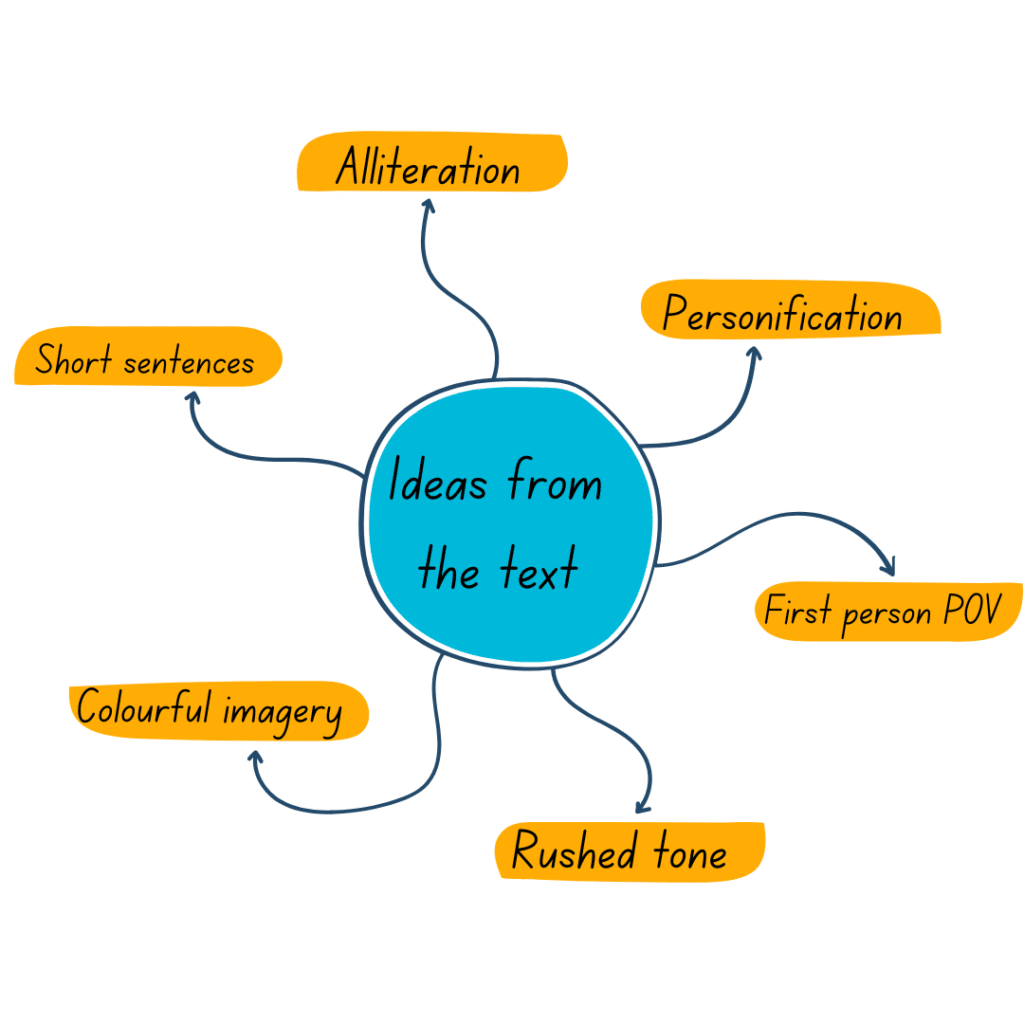Exam Basics
Exam Basics Revision
Exam Basics
In your GCSE English Language exams there are certain skills which you will need to demonstrate to the examiner.
Planning your answer carefully using the P.E.E.L method is a good way to do this.
By using this method, you can include evidence from the text and explain the effect. It will also give you the opportunity to really show the examiner your SPaG (spelling, punctuation and grammar) skills.
Planning
It is a good idea to take a few minutes to plan your answers, especially for longer mark questions.

In the writing section, think of specific points you want to convey in your answer, and note down creative techniques that you want to employ. Try not to pick what to include in your answer at random!
Instead, focus on what the question is asking and make a list of bullet points containing key features that can be crafted into a relevant argument in your response.
In the reading section, make a mind map of some general ideas. This can include key points from the text, or a list of language and structural techniques.
P.E.E.L Method
Once your planning is done, structure your answer following the PEEL method:
Point:
Start with a clear topic sentence outlining the argument you are about to make.
If it takes longer than a couple of lines, consider breaking it up into separate paragraphs to avoid large chunks of text.
Evidence:
Pick a short and concise quote from the text, one that you find particularly interesting or engaging is a good place to start.
Explanation:
Here is where you can analyse your quote thoroughly.
- Why is it interesting to you? Do any particular words or phrases catch your eye?
- How has the author tried to make their point clear or engage you?
Link:
Now is the time to link what you have just explained back to your original argument, or to the question at hand.
Try to avoid using the exact wording of the question but using similar words can help signpost to the examiner what you’re doing.

So, what is SPaG?
Spelling
Spelling words correctly seems simple, but in an exam even the most confident speller can stumble!
Practising words you find difficult, or are commonly misspelled, is a good idea to calm your nerves before the exam.
Punctuation
Using complex punctuation is a great way to make your writing more interesting and gain top marks.
Don’t be afraid to use a hyphen, bracket or semi colon; just make sure you know the rules to use them correctly!
Grammar
The way in which words fit together in a sentence or text: things like clauses and sentence lengths are grammatical features.

SPaG: Spelling, Punctuation and Grammar
SPaG is a building block of your writing! Spelling, punctuation and grammar can be tricky but getting to grips with it doesn’t take long.
What are some key rules to keep in mind?
- Capital letters and full stops throughout.
- Apostrophe rules for possession and contraction.
Contraction: the apostrophe replaces the letter that would have been there.
E.g.
-
-
- Don’t = Do not
- She‘s = She is
- They‘re = They are
-
Possession: with singular nouns, the (‘s) is added to indicate who or what owns the thing.
E.g.
-
-
- The dog‘s bone
-
- With a plural noun, one that ends with an s, an apostrophe is only used to indicate possession.
E.g.
-
-
- the drummers‘ sticks flew across the crowd
-
- Comma splicing – This is when a comma is used to join two independent clauses.
What Is The Mark Scheme Asking For?
- The sentence demarcation used is ‘consistently secure’ and ‘consistently accurate‘.
This means that the student has made correct use of full stops, capital letters and breaks throughout.
Quotes are appropriately punctuated.
- The student is able to use a ‘wide range’ of punctuation with a high level of accuracy.
For example, hyphens, semi-colons, colons, apostrophes, speech marks.
- The student is able to use a ‘full range’ of appropriate sentence forms for full effect.
This means using a range of short, compound and complex sentences in your work.
- The student is able to use Standard English ‘consistently’ and ‘appropriately’ with secure control of ‘complex grammatical structures’.
- ‘High level of accuracy’ in spelling.
- ‘Extensive’ and ‘ambitious’ use of vocabulary.
Check out our more detailed pages on the three elements of SPaG for more examples!
Example: PEEL paragraph
Q1: How does the writer persuade the reader?
In this extract, the author creates an informative tone through the use of facts and figures in order to persuade the reader.
- Here, a point about the text is stated confidently and concisely.
They briefly outline what they will be analysing (facts and figures) in order to prove their point that the author is using them persuasively.
When discussing the merits of walking over driving, the author states that walkers ‘can live up to 10 years longer on average’ than people who drive.
- This quote is well integrated into the sentence and is not too long.
By using a specific temporal reference, ‘10 years longer’ and specialist language ‘average’ the credibility of the author and the legitimacy of the overall text is enhanced.
- Thoroughly analyse your quote using technical language and explain the effect of the technique.
This helps to extend the reader’s understanding of the issue, inviting them to side with the viewpoint of the writer.
- Link back to the question, but don’t just repeat it, add your own argument

MME Premium Membership
£19.99
/monthLearn an entire GCSE course for maths, English and science on the most comprehensive online learning platform. With revision explainer videos & notes, practice questions, topic tests and full mock exams for each topic on every course, it’s easy to Learn and Revise with the MME Learning Portal.
Sign Up Now

